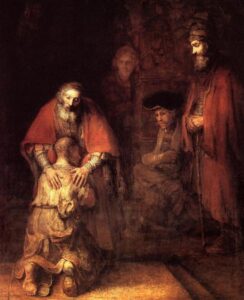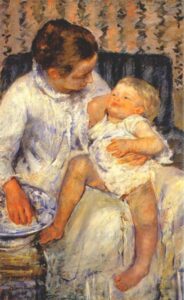How High Culture Can Save Our World
by Veronica Werth

The warning calls over the past decades are beginning to ring true. It is safe to say that our culture is in decay, but can it be saved? The answer is a resounding YES! There are many ways to approach this problem, but hopefully, this post will inspire adults to relearn—or learn for the first time—what our culture (and educational system) used to be. After beginning this journey, you will find a plethora of gifts that Western Civilization has left for us. In turn, you can pass this knowledge to younger generations (or your peers, if that be the case). May this endeavor be as exciting for you as it has been for those before you.
 In his book Modern Culture, Roger Scruton unfolds the connection between high culture and religion and even goes as far as to say that if this connection is severed, then our culture will fail. Educated persons living several centuries ago would have known the aim of poetry, art, and music. It was beauty. And if you were to ask them why beauty is important, they would have answered that it allows them to transcend the chaos and sufferings of this world to ponder a higher order of things. Our worldview seems to have gone from divinely inspired to secularization to nihilism. However, Scruton offers us a way out of the mess we are in—a renewal of high culture, since this will “continue to provide, in a heightened and imaginative form, the ethical vision that religion made so easily available.” His ethical vision is slightly different than the modernist view of a liberal arts education since Scruton directly connects the divine to the Arts.
In his book Modern Culture, Roger Scruton unfolds the connection between high culture and religion and even goes as far as to say that if this connection is severed, then our culture will fail. Educated persons living several centuries ago would have known the aim of poetry, art, and music. It was beauty. And if you were to ask them why beauty is important, they would have answered that it allows them to transcend the chaos and sufferings of this world to ponder a higher order of things. Our worldview seems to have gone from divinely inspired to secularization to nihilism. However, Scruton offers us a way out of the mess we are in—a renewal of high culture, since this will “continue to provide, in a heightened and imaginative form, the ethical vision that religion made so easily available.” His ethical vision is slightly different than the modernist view of a liberal arts education since Scruton directly connects the divine to the Arts.
In chapter 2 of the same book, Scruton defines the ethical vision. It is “what all religions deliver, and what all societies need—the vision of human beings as objects of judgment. Whether the judge be man or god; whether accounts are settled in this world or the next; whether natural or supernatural powers redeem us, judgment is the core of religion.” Great works of literature or operas offer the reader or audience an opportunity to dive into the moral imagination. What emotions should I feel? What would I do in this situation and why?
The ethical vision also requires that individuals have free will, unlike other animals, and are “… seen as supernatural beings are seen: subject, not object; cause, not effect; the invisible center of his world, but in some way not truly a part of it.” In religious terms, the image and likeness of God. That is why we value the human form, face, deed, and word. These are best revealed in the traditional themes of high art when transcendental ideas point to divine mysteries, and we realize that there is something beyond this life. We do not just live for the here and now, but are a part of the dead, living and unborn. This is why during Mass we pray for the Church Suffering and Church Militants and call on saints.
 Furthermore, the ethical vision balances our obligations of everyday life against the pull to progress for progression’s sake. There is nothing beautiful to be found in the burden of the mundane of life, says the postmodern artist. Instead, we should focus on what will make us “happy” on earth. In reality, we are losing our ideals for beauty and replacing them with “originality”, and “originality” with shock-value. Many examples of 20th-century art show a lack of proper skill, taste, and creativity. Art no longer guides us to a higher moral plane (like the obligation of a father to his child), but it assails beauty by the “Cult of Ugliness” and “Cult of Utility”. Art is nothing more than an advertisement to sell with little or no regard for beauty. Has there been a loss of ideals? Is there no longer beauty to be found in a Mary Cassatt painting? Should we aim to reject beauty for utility and materialism? No, Scruton warns, since losing the meaning of beauty leads to the loss of the meaning of life. “It turns out that nothing is more useful than the useless.”
Furthermore, the ethical vision balances our obligations of everyday life against the pull to progress for progression’s sake. There is nothing beautiful to be found in the burden of the mundane of life, says the postmodern artist. Instead, we should focus on what will make us “happy” on earth. In reality, we are losing our ideals for beauty and replacing them with “originality”, and “originality” with shock-value. Many examples of 20th-century art show a lack of proper skill, taste, and creativity. Art no longer guides us to a higher moral plane (like the obligation of a father to his child), but it assails beauty by the “Cult of Ugliness” and “Cult of Utility”. Art is nothing more than an advertisement to sell with little or no regard for beauty. Has there been a loss of ideals? Is there no longer beauty to be found in a Mary Cassatt painting? Should we aim to reject beauty for utility and materialism? No, Scruton warns, since losing the meaning of beauty leads to the loss of the meaning of life. “It turns out that nothing is more useful than the useless.”
The ethical vision also safeguards networks of relationships. Every individual, no matter where he falls on the social hierarchy, is important. We are more than a consumer, a worker, or a scientist. We need to be taught what to feel and why we should feel it towards social situations such as birth, suffering, and death. It reminds us to cherish those around us and life itself, despite the suffering with which we are challenged.
“The great artists of the past were aware that human life is full of chaos and suffering, but they had a remedy for this, and the name of that remedy was beauty. The beautiful work of art brings consolation in sorrow and affirmation in joy. It shows human life to be worthwhile.” – Why Beauty Matters
Overall, the ethical vision gives sense to our lives. Beauty goes beyond sexual desire and can therefore be found not only in a painting of a beautiful woman but also in the aging face or a scene from ordinary life. However, the religious approach to beauty was changed by the scientific revolution. The Enlightenment sowed doubt in the ethical vision by claiming to rid our world of the superstitions of religion. Our society continues to lose its “godwardness” because the postmodernists have replaced the sacred with materialism and ultimately nihilism. Scruton calls us to reorganize our lives through the recovery of the spiritual and aesthetic connection of the Arts. High culture sets the individual within the group and teaches him, unlike science, what to feel. The extension of the “repertoire of emotions” can remedy the plague of acedia that continues to plague modern people (as Dom Jean-Charles Nault wrote about in his book “The Noonday Devil: Acedia, the Unnamed Evil of Our Times”); and it re-directs—in a positive way—the behavior of generations of boys who are negatively affected by New Wave feminists. This is not an easy task, says Scruton, but one we must accept to save our culture. If we remove from its sacred place the golden calf of fake art, pop music, and soul-less architecture, he continues, we can replace it with a proper ethical vision, one where “[w]e must be fully human while breathing the air of angels; natural and supernatural at once. A community that has survived its gods has three options. It can find some secular path to the ethical life. Or it can fake the higher emotions while living without them. Or it can give up pretending, and so collapse, as Burke put it, into the ‘dust and powder of individuality.’”
For more information on this topic, you are encouraged to reference the cited work, as well as those listed below.
Read:
Beauty: A Short Introduction. Roger Scruton. Summary here.
Watch:
BBC documentary “Why Beauty Matters”
“Conference on Beauty and the Restoration of the Sacred” by Catholic Art Guild
View:
National Gallery of Art, Washington, DC– Learn from home
National Gallery, London—Learn from home
